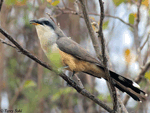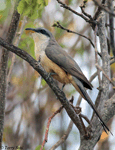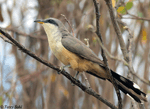| Length: 12 inches | Wingspan: 17 inches | Seasonality: Non-resident in South Dakota |
| ID Keys: Thicker bill than other cuckoos, black and white tail with dark edge, buffy belly, brownish upperparts, two-tone bill | ||
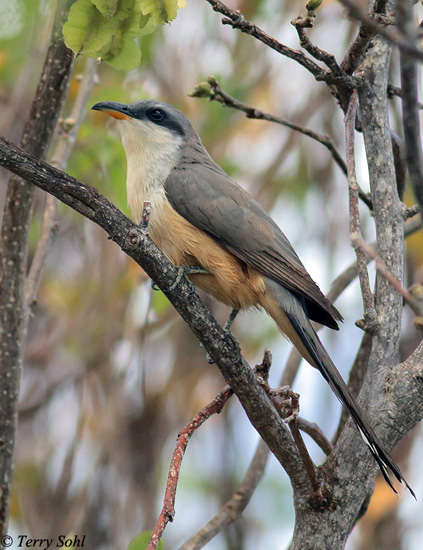 The
Mangrove Cuckoo is a well-named species that occupies mangrove stands in
Florida in the U.S., as well as mangroves and other forest types in the
tropics of the Northern Hemisphere. They are a difficult bird for
people to spot, as they are often found in very dense vegetation, and prefer
tropical forested habitats that are sometimes difficult to investigate.
They are typically heard much more often than they are seen.
The
Mangrove Cuckoo is a well-named species that occupies mangrove stands in
Florida in the U.S., as well as mangroves and other forest types in the
tropics of the Northern Hemisphere. They are a difficult bird for
people to spot, as they are often found in very dense vegetation, and prefer
tropical forested habitats that are sometimes difficult to investigate.
They are typically heard much more often than they are seen.
Habitat: Found in in mangrove forests in the U.S. part of its range, as well as in some tropical hardwood species. In the rest of its tropical range, the Mangrove Cuckoo is found in mangroves, but also in other types of woodlands. Not necessarily always found near water in the tropics, with some birds nesting far from water sources.
Diet: Feeds on insects and spiders, with a particular preference for caterpillars, like other cuckoo species. They will also sometimes feed on small vertebrates such as small frogs, and sometimes will feed on vegetative material such as fruits and berries.
Behavior: Moves slowly through the branches and foliage of trees and shrubs, searching for insects.
Nesting: The nest of a Mangrove Cuckoo is in a mangrove tree or other small tree, typically relatively close to the ground or water. The nest is a simple stick platform, upon which the female lays 2 or 3 eggs. Both parents help to incubate the eggs, and both parents help to feed the young after they hatch.
Song: The song of a Mangrove Cuckoo is a nasal repeating series of notes that slowly speeds up, and end with a pair of lower, longer tones.
Migration: Considered a permanent resident throughout its tropical range. They were once considered only a summer visitor in Florida. However, they have increasingly been identified during the winter months, and it may just be that overwintering birds are rarely seen due to the birds' habits and the dense habitat they typically occupy. There's little doubt that some birds are migratory, given that stray birds are sometimes seen in Texas and along the Gulf Coast.
Interactive eBird Map: Click here to access an interactive eBird map of Mangrove Cuckoo sightings
Similar Species: Most similar to Yellow-bellied Cuckoo. Also similar to Black-billed Cuckoo.
Conservation Status: Populations of the Mangrove Cuckoo are widespread and appear to be stable. The IUCN lists the Mangrove Cuckoo as a species of "Least Concern".
Further Information: 1) Mangrove Cuckoo - WhatBird
2) Audubon Guide - Mangrove Cuckoo
3) Cornell's NeoTropical Birds - Mangrove Cuckoo
Photo Information: Photo taken in June, 2015 - Terry Sohl - St. John's Island, U.S. Virgin Islands
| Click below for a higher-resolution map |
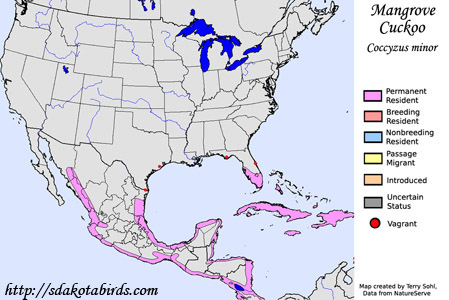 |
| South Dakota Status: Non-resident in South Dakota |
Additional Mangrove Cuckoo Photos
